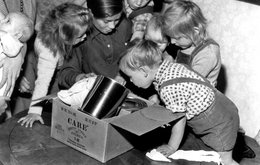The first CARE packages
CARE was set up in the USA 80 years ago, in 1945, to respond to the devastation and scarcity brought on by World War 2. Originally, Americans paid $10 to send a ‘CARE package’ to someone in Europe. These packages contained food and essential supplies, like canned meats, powdered milk, coffee and chocolate.
These small acts of kindness were an early form of international aid – delivered not just by governments but by individuals to people in need across the world. For the families who received a CARE package it represented goodwill and a message of hope, delivered from someone far away with a simple human desire to help them.
Today, 80 years on, that kindness is needed more than ever. Right now, millions of women and families around the world are facing unimaginable hardship.
You can help change this - will you consider sending a CARE Package today? Your donation could help provide urgent supplies like food and medicine to women and their families who need them most.
Global expansion
CARE has grown a lot since then, expanding our remit beyond immediate and short-term relief to more long-term assistance in the form of recovery and rehabilitation. Today, we are a global network of partners working in over 120 countries to save lives, defeat poverty and achieve social justice. We work with communities, so they have the power, resources, and opportunities they need to survive and thrive.
But the spirit of human kindness, present in those first CARE packages all that time ago, remains at the heart of everything we do.
-

The first ever CARE packages: Megan’s story
Megan and her family were some of the first ever CARE Package recipients. Here she tells us her memories of that time, and her reflections on why CARE Packages are still so important today.
-

The story of aid in a CARE package
CARE was first set up in 1945 to send ‘CARE packages’ from people in the USA to people in Europe recovering from World War II.




